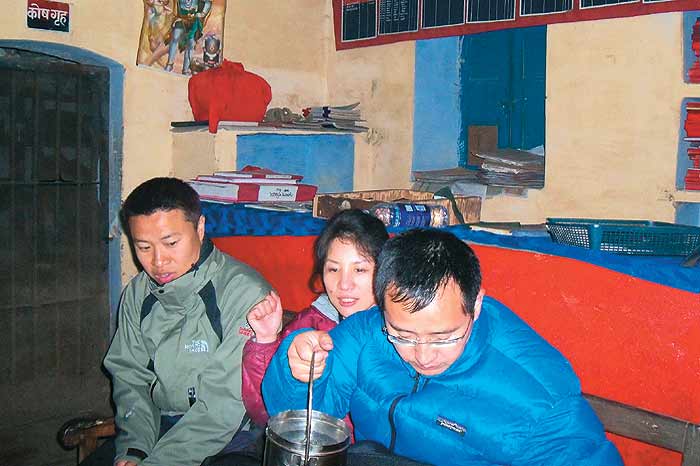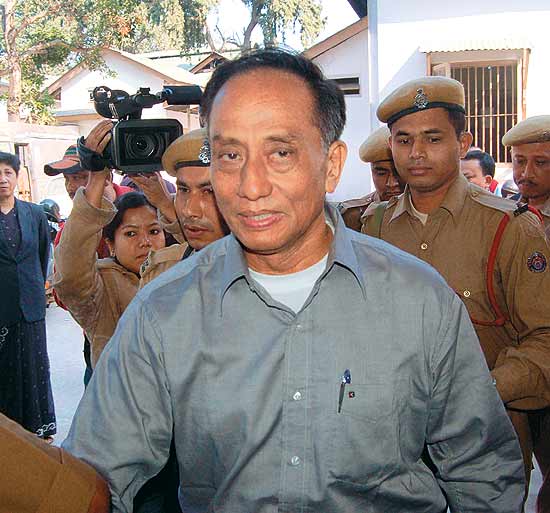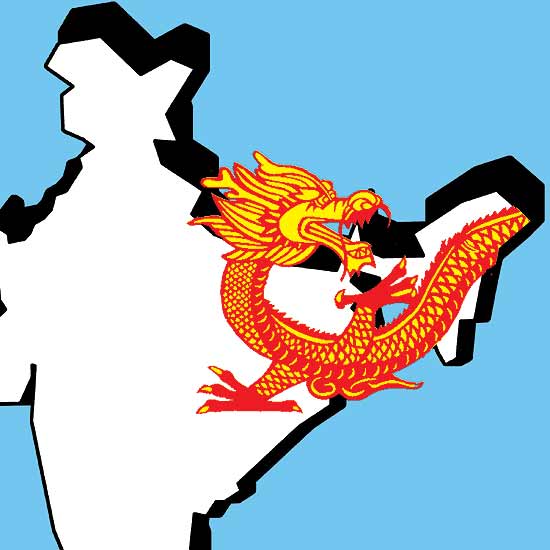ajtr
BANNED

- Joined
- May 25, 2010
- Messages
- 9,357
- Reaction score
- 0
The Great Claw of China
The confessions of NSCN(IM) leader Anthony Shimray show exactly how China is fuelling India’s northeastern insurgencies

Wooing NSCN (IM)
China agrees to host a permanent representative of the NSCN (IM) from 2008
The outfit is asked to spy on Indian troops in Arunachal Pradesh and the Dalai Lama
Pakistan’s ISI also contacts NSCN (IM) and asks it to break the ceasefire with India
NSCN (IM)’s firepower grows significantly during the ceasefire with India that began in 1995
For decades, India and China have played a cat-and-mouse game, full of intrigue and suspense. Even while New Delhi is trying to find ways around vexatious border issues or making occasional noises about stapled visas, Beijing has been secretly supporting, advising and arming major insurgent outfits in India’s troubled Northeast and the Maoist belt. Unlike the noise and heat the Indo-Pak relationship generates, Indian diplomats maintain a studied silence when it comes to the Chinese hand in the Northeast or arms from across the border reaching Maoists in central India.
In the last three months, however, the Chinese hand in the Northeast has been revealed in great detail. In the early hours of October 2 last year, Indian intelligence officials, along with their counterparts in the National Investigation Agency, accosted a tall, hefty man waiting outside the Patna railway station. The quarry was Anthony Shimray, a key official of the National Socialist Council of Nagalim (Isak-Muivah) faction or NSCN(IM), the biggest insurgent outfit in the Northeast. Not only is Shimray a powerful member of the NSCN(IM)’s top leadership, he is also the nephew of its general secretary, T. Muivah, currently in New Delhi for peace talks with the Centre. As the chief arms procurer for the outfit, Shimray also has first-hand information on Chinese efforts to support insurgencies.

Shimray: Tailed and Nabbed
Shimray’s early morning arrest was the culmination of a meticulous operation conducted by India’s external intelligence agency RAW in the preceding weeks. They had managed to track down Shimray in the middle of September. He was operating out of Bangkok, a haven for arms dealers, insurgents and intelligence agencies. It was to be a tricky call: Shimray could not be nabbed in a foreign land, and there was considerable debate within the government on picking him up since this was in the midst of a dialogue with NSCN(IM). Finally, with clearance, intelligence officials had a stroke of luck.
By the end of September, the sleuths had gathered from their sources that Shimray would need to travel from Thailand to get his visa renewed and visit his cadres in Manipur and Nagaland. Quietly, they managed to procure his travel details to Nepal and began to monitor his exit from Bangkok. Shimray took a Royal Nepal Airlines flight to Kathmandu in the early hours of September 27 and proceeded by road to quietly slip across the Indian border into Bihar. From here, he was to proceed by rail to the Northeast but he was arrested before that.
His subsequent interrogation has been detailed in a 100-page report, accessed exclusively by Outlook. It throws up several startling truths about the Chinese hand in Indian insurgencies. While Shimray speaks at length about NSCN(IM), he also reveals China’s links with ULFA and the National Democratic Front of Bodoland (NDFB) in Assam and the United National Liberation Front in Manipur. Here are Shimray’s key revelations:

Paresh Barua at an ULFA training camp near China-Myanmar border. (Photograph by U B Photos, From Outlook, February 07, 2011)
Chinese Arms for the Northeast
Even as recently as September 25, 2010, Shimray was procuring arms and had held further talks with his middleman in Bangkok, Willy Narue. One consignment being negotiated was for Arunachal Pradesh. He even asked the suppliers if they could deliver in the “upper part of Arunachal from the Chinese side”. Investigators feel Shimray’s covert October trip to India may have been tied to the arms deals.
Shimray also told his interrogators how he procured arms from the Chinese in late 2007. “It was decided by our leadership stationed in New Delhi to strengthen the weaponry of the organisation,” he reveals. With Narue’s help, he contacted Yuthuna, a Chinese representative of TCL in Bangkok, TCL being the “authorised subsidiary of the Chinese arms company China Xinshidai, Beijing”. On its website, Xinshidai is described as dealing in the import and export of specialised products by China’s defence industries.
The final shopping list included 600 AK series rifles, nearly 6 lakh ammunition rounds, 200 sub-machine guns, pistols, rocket launchers, light machine guns and 200 kg of RDX. The deal was worth $1.2 million, with an additional $1 million for shipment from China. The consignment was sent through a shipping agent in Kittichai of Bangkok-based Intermarine Shipping. It was to be “loaded from Beihei, a south Chinese port. The destination was Cox’s Bazaar”, a major landing station on the Bangladesh coast. “All the correspondence with Willy Narue, our leadership in New Delhi, Nagaland and others in Thailand and China,” Shimray says, “was made on e-mail to maintain the secrecy of the entire project.” The information was saved as a draft and accessed by Chinese intelligence using Shimray’s password.
Shimray also recalled his visit to China in 1994 for a joint arms deal for NDFB. The “procurement of the arms and ammunition” was “made from the Chinese company NORINCO”. This consignment included “1,800 pieces of arms and one lakh rounds, which included AK series rifles, M16 automatic assault rifles, machine guns, sniper rifles, rocket launchers and pistols”. The money came from a Naga businessman using Calcutta-based hawala operators.
Again, in 1996, “arms and ammunition were brought from Beijing to Cox’s Bazaar in a North Korean ship”. After the consignment was unloaded in small boats on the high seas and transferred in trucks to NSCN(IM) camps in Bangladesh, it travelled to the Northeast.
China Hosts Permanent Representative of NSCN(IM)
In another significant revelation, Shimray details how China’s relationship with the NSCN(IM) was strengthened in 2008 when it agreed to host their permanent representative. The year also seems to have been a watershed moment in the NSCN(IM)’s relationship with China and its renewed efforts to arm itself. And ironically, in the midst of a 15-year-dialogue it has been having with New Delhi.
According to Shimray, in a letter from ‘Prime Minister’ Muivah addressed to senior Chinese intelligence officials, Kholose Swu Sumi, a 60-year-old member of the Sema tribe in the Zunheboto district of Nagaland, was appointed as the permanent representative of the NSCN(IM) in China. Kholose’s acceptance by the Chinese was an official acknowledgement of a formal relationship with the NSCN(IM). Kholose was promoted to the rank of a colonel and asked to interface with the Chinese. “His main job was to update the Chinese authorities about the development of peace talks and the activities of the Indian army and to pass on the response of the Chinese authorities to the collective leadership of NSCN(IM),” says the interrogation report recording Shimray’s confessions.
Kholose, who ran a business in precious stones, received Shimray and his wife at Kunming airport (Yunnan province, southeastern China) on a visit and introduced him to several Chinese intelligence officials. “He introduced me to Mr Chang, head of intelligence of the region in Dehong Mangshi,” Shimray told his interrogators. “Mr Lee Wuen, head of intelligence of Yunnan province, was also introduced to me. I gave them the message of our leadership, that NSCN(IM) wanted their assistance and cooperation.”

Suspicious lensmen Chinese nationals arrested by the UP police in January
Forging Military Cooperation and Spying on India
Shimray also talks of a visit to China in the summer of 2009. This time, he accompanied his ‘President’, Isak Chisi Swu. “The visa for the visit,” says Shimray, “was arranged by the Chinese intelligence authorities at the Chinese embassy in the Philippines.” The trip helped the NSCN(IM) leadership forge “military cooperation” with the Chinese. But, “in lieu of extending military cooperation,” says Shimray, the NSCN(IM) was to “give information on the movement and activities of the Dalai Lama in India and the movement and facilities of (the) Indian army in Arunachal Pradesh”.
NSCN(IM) cadres in the border district of Tirap in Arunachal Pradesh began to immediately monitor Indian troop movements. Shimray contacted a Naga journalist in Delhi, paid her Rs 80,000, and persuaded her to travel to Dharamsala, the headquarters of the Dalai Lama, to gather intelligence. “For getting information on the movements and activities of the army in Arunachal Pradesh, we collected the information through our cadres in Tirap district and our New Delhi office,” Shimray told the investigators. “I passed on this information to an official of the Chinese intelligence agency.”
In his reports to Chinese intelligence, Shimray would use code words such as “Awo” to designate China and “Mayang” for India. He also conveyed the information using the e-mail id angel3phi@ yahoo.com, which would be accessed by a Chinese intelligence officer using the same password. While Shimray was in constant touch with the Chinese, other senior NSCN leaders such as ‘deputy minister’ Kehoi too were making contacts with Chinese authorities. In addition, NSCN(IM) commander-in-chief V.S. Atem also had some Chinese contacts.
Interestingly, the Uttar Pradesh police arrested three Chinese citizens in January who had illegally crossed into India and were found photographing border check-posts. In the same month, a 39-year-old Chinese woman, Wang Qing, was arrested and deported after she illegally travelled to Nagaland and also met Muivah. She was reported to be from the People’s Security Bureau, the Chinese intelligence agency.
ISI Links
In a subsequent interrogation, Shimray also gives interesting insights into his relationship with Pakistan’s ISI which tried to engage with the northeastern insurgents on several occasions. The NSCN(IM) leadership was received by “the Pakistani intelligence officials” in Karachi way back in 2001 even as the NSCN(IM) was negotiating peace with New Delhi. In 2008, an ISI agent working under the pseudonym of “Mr Rex” and stationed in Bangladesh visited the NSCN(IM) leadership in Bangkok and offered “financial help as well as military training” if the Nagas broke the ceasefire with India.
It is, however, the China factor that continues to be a major irritant for New Delhi even as peace talks continue with the Nagas. It has already expressed its displeasure at China’s stapled visas to Kashmiris and Arunachalis, its denial of a visa to an Indian army general and its efforts to arm and support the insurgency in the Northeast. The balance of power between the elephant and the dragon, it seems, will continue to oscillate before it can stabilise.
http://www.outlookindia.com/article.aspx?270223







